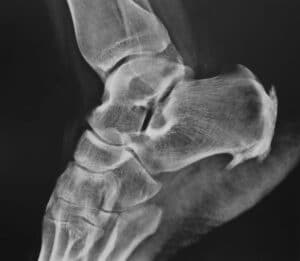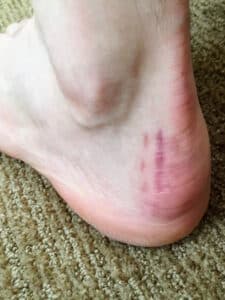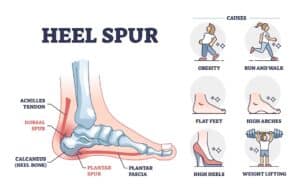Minimally Invasive Hammertoe Surgery Miami
If you happen to struggle with a foot deformity such as hammertoe, finding a trusted podiatrist who will provide you with a surgical correction is necessary. One of the most common procedures for this type of deformity is minimally invasive hammertoe surgery. If you are curious to find out more about it and figure out if this is the procedure you can benefit from, keep reading. We’ve explained everything you can expect from this surgery in the text below.
AVERAGE COST
$2,500 - 3,000
PROCEDURE TIME
20 – 40 Min
BACK TO WORK
1 week
FULL RECOVERY
2 weeks
Book Your Free Consultation
Key Points on Minimally Invasive Hammertoe Surgery
Before we explain everything about correcting a hammertoe via surgical procedure, we should start by explaining what this condition actually means. Hammertoe deformity (also known as claw toe or mallet toe) is a common problem that occurs on lesser toes (most commonly, the second toe). It means a toe is permanently bent at a certain angle and can’t be straightened. This causes pain when weight-bearing or wearing shoes and can cause pressure between adjacent toes.
Usually, the condition is developed thanks to tight flexor tendons, which cause toes to curl up and remain in an irregular position. This can happen due to trauma, uncomfortable footwear, arthritis, certain foot structure, or even genetics. Hammertoe can also be closely related to hallux valgus, also known as the bunion of the hallux. The affected joint may remain flexible for some time, but it will gradually become more and more rigid.
Get a 10% Discount on Minimally Invasive Bunion Surgery
Eventually, the surgery remains the only solution, but it doesn’t have to be an invasive procedure. Nowadays, the most common surgical procedure to fix hammertoe is a simple outpatient procedure – a minimally invasive hammertoe surgery. This means your podiatrist will make a simple, small incision and release the tight tendon. You don’t even need to be put under general anesthesia for this – local anesthetic and a sedative will be more than enough.

Key Points on Minimally Invasive Hammertoe Surgery
Before we explain everything about correcting a hammertoe via surgical procedure, we should start by explaining what this condition actually means. Hammertoe deformity (also known as claw toe or mallet toe) is a common problem that occurs on lesser toes (most commonly, the second toe). It means a toe is permanently bent at a certain angle and can’t be straightened. This causes pain when weight-bearing or wearing shoes and can cause pressure between adjacent toes.
Usually, the condition is developed thanks to tight flexor tendons, which cause toes to curl up and remain in an irregular position. This can happen due to trauma, uncomfortable footwear, arthritis, certain foot structure, or even genetics. Hammertoe can also be closely related to hallux valgus, also known as the bunion of the hallux. The affected joint may remain flexible for some time, but it will gradually become more and more rigid.
Get a 10% Discount on Minimally Invasive Bunion Surgery
Eventually, the surgery remains the only solution, but it doesn’t have to be an invasive procedure. Nowadays, the most common surgical procedure to fix hammertoe is a simple outpatient procedure – a minimally invasive hammertoe surgery. This means your podiatrist will make a simple, small incision and release the tight tendon. You don’t even need to be put under general anesthesia for this – local anesthetic and a sedative will be more than enough.
1. Initial Consultation
Like any medical condition, individual assessment of a patient is of utmost importance. Your doctor will do a detailed examination to determine whether your condition is the right fit for this type of surgery. The initial consultation will determine the next step.
There is not just one answer to the patient’s problem – the individual approach is extremely important, and your doctor will determine what would be the right way to proceed. However, the question is – how do you even know if it’s time to schedule a consultation? Here are the most common symptoms that lead patients to our waiting room:
- The pain is persistent and keeps getting worse,
- You can hardly stand, walk, or even wear shoes due to pain,
- The pain limits your everyday activities and affects your quality of life,
- Non-surgical treatment has failed to help with the condition.
2. Surgery Duration
The best thing about outpatient procedures such as this one is that they are extremely safe and quick. The entire time you will spend in our Luxe Foot Surgery clinic will be less than two hours. In fact, the approximate time required for minimally invasive hammertoe surgery is about 90 minutes, including pre-op and post-op. The surgery itself is pretty standard and straightforward.

After making a small, three-millimeter incision, the podiatrist will straighten or cut the tendon that’s causing the problem, and that’s basically the entire process. There is no need for any hardware – no pins or screws are necessary, and the correction is maintained by taping and wrapping every two weeks until 6-8 weeks post-operation.
3. Discomfort
What level of pain and discomfort should you expect after the procedure? Even though this is a minimally invasive surgery, it would be unreasonable to expect no pain at all. However, the level of discomfort you will feel is minimal – you will be able to stand on your feet the same day after the surgery. When it comes to pain during surgery, know that there won’t be any – thanks to local anesthesia, all you will feel is a slight pressure.
Thanks to a small incision, scarring and soft tissue disruption will be minor inconveniences as well. Your hammertoe surgery will provide you with the best results with almost no discomfort. It’s clear that the postoperative pain will be nothing compared to the persistent pain of a hammertoe.
4. Recovery
Don’t worry, you won’t experience much discomfort, and the recovery time for minimally invasive hammertoe surgery is quite short.
You will be able to walk the same day after the surgery, you will be able to carry your own weight immediately after the procedure despite the discomfort. You may need a walker or crutches to help with the balance, and you will be provided with special post-op shoes to help with the recovery. It might not seem like it’s easy to get back to walking immediately after the surgery, but it’s actually healthy for your soft tissue and bones to adjust to the surface right after the changes that have been made.

Of course, you are not expected to take long walks immediately after the surgery – the distance you walk should be gradually increased, and after about two weeks, you won’t need a walker or crutches anymore. You will be able to return to normal shoes after six weeks. When it comes to demanding physical activities such as sports, you can expect to be fully recovered after about ten weeks.
5. Final Results
What results are to be expected after minimally invasive hammertoe surgery? Even though it’s a simple procedure, the results will be exactly what you’re hoping for – a completely corrected deformity and balance improvement. This kind of correction might not take a lot of time to be done, but it certainly requires plenty of expertise and experience from your podiatrist – obviously, taking the time to carefully choose your doctor is essential.
Aesthetic improvement isn’t the only thing to look forward to. In fact, if your hammertoe has been causing severe pain (like in most cases), we believe that the main benefit you’re looking forward to is being relieved of pain. After the surgery, weight-bearing will be painless. You will be able to walk effortlessly, and your overall quality of life will improve. It’s also worth mentioning that various shapes of shoes won’t cause you discomfort anymore.
For such a simple procedure, minimally invasive hammertoe surgery certainly brings plenty of benefits. However, you should keep in mind the possibility of reoccurring hammertoe. It doesn’t happen often, but it’s possible. In that case, your podiatrist will need to do a detailed checkup and determine what might be causing the permanent symptoms. Still, 80-90% of hammertoe surgeries end up being successful.
How Much Is a Minimally Invasive Hammertoe Surgery in Miami?
The cost for a minimally invasive hammertoe surgery in Miami typically ranges from $5000 to $9000, providing an effective and less intrusive solution to correct the deformity. These prices often encompass various factors such as the surgeon’s fees, facility costs, anesthesia, and follow-up care.
However, individual costs may vary based on the complexity of the case and the specific healthcare provider. Although it’s a substantial investment, this procedure offers benefits like reduced recovery time and less postoperative discomfort compared to traditional surgery. It’s recommended to discuss with your healthcare provider or insurance company about potential financial assistance or payment plans.
All about Hammertoe surgery recovery
Compared to traditional surgical procedures (open surgery), minimally invasive techniques require less time to recover. The reason for this is simple – with such a small incision like the one performed during minimally invasive hammertoe surgery, there isn’t a lot of injury to soft tissue.
You won’t experience much pain – still, a certain level of discomfort is to be expected. Some patients need pain medication, but some don’t – it depends on the individual.
Additionally, as this kind of surgery doesn’t require general anesthesia, you won’t feel sleepy, have muscle aches, or feel nauseous (all of these things are common side effects of general anesthesia). With all this in mind, let’s take a look at the approximate recovery time you’re looking at after minimally invasive hammertoe surgery.
How Long Is the Recovery?
The recovery period should take only a few weeks – compared to recovery after traditional surgical approaches, this is way better and easier for the patient. Immediately after the surgery, you will be able to get back on your feet – weight-bearing is recommended on the same day post-op so the soft tissue, bones, and joints can get used to the surface as soon as possible. The distance you can go will gradually increase in the days and weeks after the procedure.
When the surgery is completed, you will be provided with specially designed footwear that will help with recovery. This footwear should be worn for about six weeks, and after that, you can get back to your regular footwear (but still, make sure you pick something comfortable to wear until your foot has fully recovered). You will also most likely need crutches or a walker in the first two weeks after the procedure to help with your balance, but the pain itself shouldn’t be a severe issue.
Tips for Recovery
What can help speed up the recovery process? Even though the recovery doesn’t take long, you can still do something to make it even shorter. Elevating the foot is a crucial thing – it will reduce swelling. You can place the foot on a pillow or rest it against the wall. Following the instructions your podiatrist gives you is also essential – don’t underestimate the importance of the special footwear they will provide you with after the procedure.
Physical therapy can be helpful for recovery, but it might not be necessary for some patients. Lastly, one thing you shouldn’t overlook is the change in lifestyle. What does this mean for a hammertoe deformity? For the most part, it means avoiding uncomfortable, narrow shoes and high heels. Make sure you wear comfortable footwear with a wide-toe box or open-toe shoes.
How do I prepare for surgery?

Who is a good candidate?
How painful is Hammertoe Surgery?
Have a consultation with your surgeon in Miami before the Hammertoe Surgery
Frequently asked questions
While traditional surgical procedures can leave scars, minimally invasive hammertoe correction will leave little to no scarring. This is thanks to the extremely small incision that’s performed during the procedure.
As opposed to traditional surgical approaches, this kind of surgery doesn’t come with many risks or complications. Risks of minimally invasive hammertoe surgery include nerve damage, failure to correct the deformity, and shortening of the bone. There is a chance of an infection and blood clots. You might experience weakness in your toes as well.
You can elevate your leg with the pillow or rest it against the wall. This will help reduce postoperative swelling (and, thus, pain). However, keep in mind that, with minimally invasive hammertoe correction, extensive swelling is not expected, so that’s not something you should worry about.
Since we are talking about a minimally invasive hammertoe surgery, you will be able to walk the same day after the procedure – but you shouldn’t expect to be able to walk long distances. You will need a walker or crutches for the first two weeks post-op. The distance you can walk will gradually increase every day.
This depends on the type of work you do – if the work doesn’t require standing for an excessive amount of time, you will be able to return immediately following the surgery. However, if your work involves excessive physical activity, you might need to take a few days off.
While you will be able to walk immediately after the procedure, it is recommended that you hold back with an intense workout until ten weeks after the procedure.
Latest Articles

The Breakdown of Haglund’s Deformity Surgery Cost
Haglund’s deformity is a bony protrusion on the back of the heel. This podiatric condition is a result of calcaneus

What to Expect – Haglund’s Deformity Surgery Scar
Haglund’s deformity or syndrome is a protrusion on the back of the heel caused by an enlargement of the calcaneal

How Long Does Haglund’s Deformity Surgery Tak
Haglund’s deformity, also known as Mulholland deformity, is a bone and soft tissue abnormality on a person’s heel. It causes

Managing Pain After Haglund’s Deformity Surgery – What to Expect and Tips for Relief
Make the recovery phase after Haglund’s deformity surgery a breeze. Learn tips and tricks for managing pain after Haglund’s deformity

What to Expect After Haglund’s Deformity Surgery
When Haglund’s deformity proves to be resistant to all non-surgical remedies, such as changing footwear, anti-inflammatory drugs, and physiotherapy, surgical

Can Haglund’s Deformity Recur After Surgery? Understanding the Possibilities
When it comes to some of the most stubborn health issues, foot conditions are at the top of the list.

Haglund’s Deformity Post Surgery: A Comprehensive Guide
Each surgical procedure has a unique recovery period, no matter how minimally invasive it is. There will be certain things

What Are the Main Haglund’s Deformity Surgery Risks? An In-Depth Overview
As with any other medical procedure, Haglund’s deformity surgery comes with its own set of risks and potential complications. Before

Returning to Running After Haglund’s Deformity Surgery – A Guided Journal
When can you return to running after Haglund’s deformity surgery? Physical therapy and a smooth recovery process impact how soon

Dorsal Heel Spur Surgery – Procedure, Recovery, and What to Expect
Dorsal heel spur surgery is a procedure that alleviates irritating symptoms caused by heel spurs that develop on the back

Understanding the Costs of Laser Corn Removal
Alleviating discomfort and nagging pain caused by corns on the patient’s feet has never been easier to do. Removing painful

Minimally Invasive Hammertoe Surgery Cost – An Informative Guide
Do you need pain relief from a bent toe joint? Fortunately for many patients, there is a minimally invasive surgery